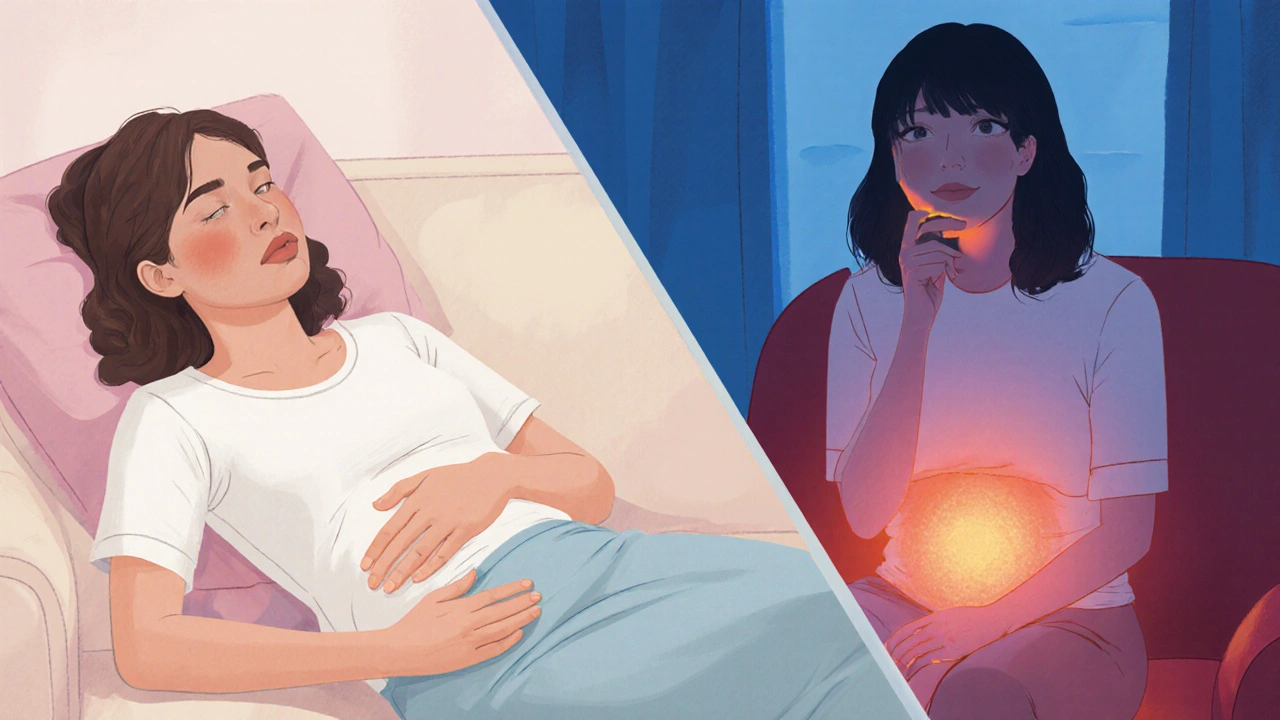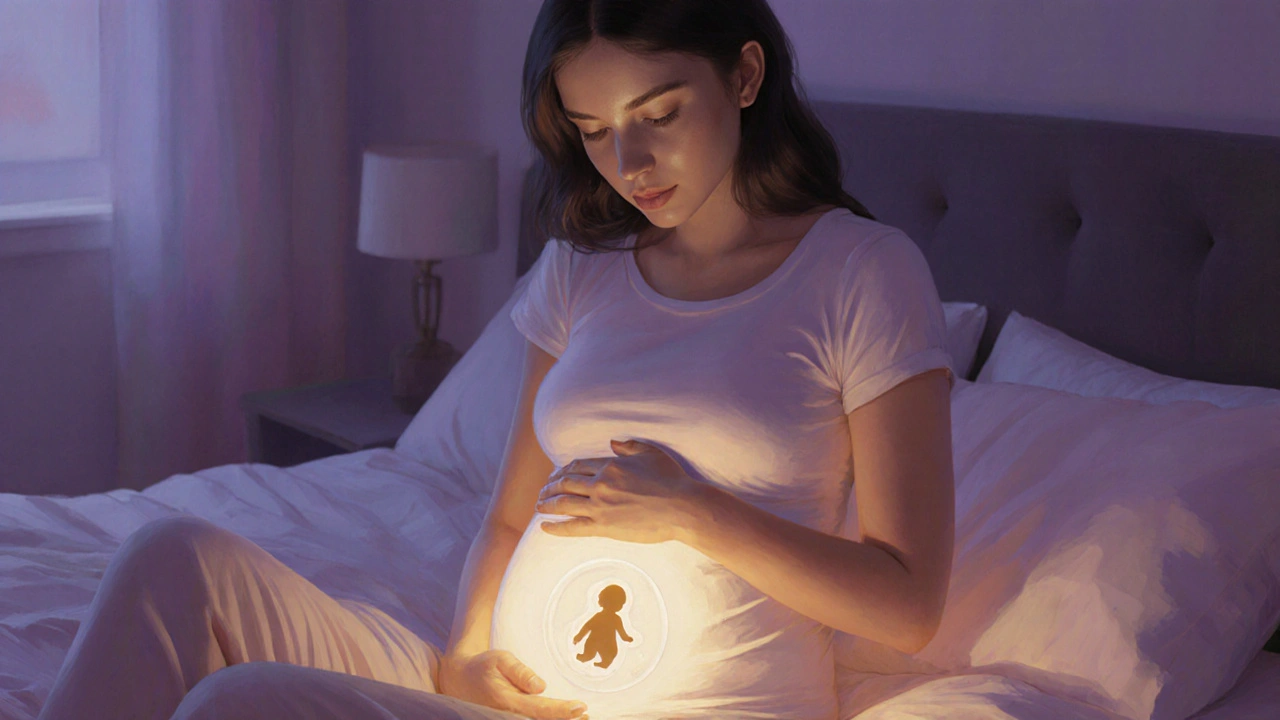Implantation vs. Menstrual Cramps Checker
Use this tool to help determine whether your cramping is likely due to implantation or a regular menstrual period.
Timing of Cramps
Intensity of Cramps
Associated Symptoms
Location of Pain
Quick Take
- Cramping can continue once you’re pregnant, but its cause changes.
- Implantation cramps happen about a week after conception and are usually milder than typical period pain.
- Persistent, severe, or localized pain may signal a problem such as miscarriage or ectopic pregnancy.
- Gentle heat, hydration, and light movement often ease normal pregnancy cramps.
- Contact a healthcare provider if cramps are accompanied by heavy bleeding, fever, or sudden intensity.
When you hear menstrual cramps mentioned alongside pregnancy, it can feel confusing. Your body is juggling hormonal shifts, a growing uterus, and the early stages of a new life-all of which can create sensations that look a lot like your regular period pain. This guide breaks down what’s happening, how to tell the difference between harmless cramping and warning signs, and what you can safely do to feel more comfortable.
Menstrual cramps are painful uterine contractions that occur during a period, usually caused by the hormone prostaglandin. While they’re most common during the luteal phase of the menstrual cycle, many women notice similar sensations after they become pregnant.
Why Cramping Happens in Early Pregnancy
Once fertilization occurs, the embryo travels to the uterine lining and begins to embed itself. This implantation process triggers a surge of hormones-especially progesterone and estrogen-that prepare the uterus for pregnancy. Two main mechanisms create cramping:
- Implantation cramps: Small, localized aches that happen 6-12 days after ovulation as the embryo burrows into the lining.
- Uterine remodeling: As the uterus expands, its muscle fibers stretch and contract, sometimes producing a dull ache similar to menstrual pain.
Both are normal and typically short‑lived. The intensity is usually milder than what you experience during a heavy period, and the pain often fades within a few hours to a couple of days.
Implantation Cramps vs. Regular Menstrual Cramps
| Feature | Implantation Cramps | Menstrual Cramps (Dysmenorrhea) |
|---|---|---|
| Timing | 6‑12 days after ovulation, often before a missed period | Starts 1‑2 days before period, peaks during days 1‑3 of bleeding |
| Duration | Minutes to a few hours, rarely more than 2 days | Typically lasts 2‑3 days, can extend throughout the period |
| Intensity | Light to moderate, described as a tightening or dull ache | Can be mild, moderate, or severe; often described as sharp or throbbing |
| Location | Lower abdomen, sometimes unilateral (one side) | Lower abdomen, often bilateral (both sides) |
| Associated Symptoms | Light spotting, mild nausea, breast tenderness | Headache, bloating, lower back pain, fatigue |
When Cramping Is a Sign Something’s Wrong
Most early‑pregnancy cramping is harmless, but certain patterns deserve a prompt call to your OB‑GYN or midwife:
- Heavy bleeding that looks like a period or heavier, especially if clots are present.
- Sudden, sharp pain on one side that intensifies quickly-possible ectopic pregnancy.
- Persistent pain lasting more than a week without relief.
- Fever, chills, or vomiting alongside cramps-could indicate infection.
- Dizziness or fainting while standing, suggesting low blood pressure or internal bleeding.
These red flags often point to miscarriage risk, ectopic implantation, or other complications. Early medical evaluation can protect your health and, when possible, the health of the embryo.

Safe Ways to Ease Normal Pregnancy Cramping
Because you’re pregnant, you need to avoid certain over‑the‑counter options that are safe for period pain but not for early gestation. Here are doctor‑approved methods:
- Heat therapy: A warm (not hot) compress or a heating pad on a low setting for 15‑20 minutes can relax uterine muscles.
- Gentle movement: Light walking, prenatal yoga, or swimming improves circulation and reduces stiffness.
- Hydration: Dehydration worsens cramping; aim for 2‑3 liters of water daily.
- Magnesium‑rich foods: Leafy greens, nuts, and seeds can help muscle relaxation.
- Acetaminophen: If pain is bothersome, acetaminophen (paracetamol) is generally considered safe in pregnancy when used as directed. Avoid NSAIDs (ibuprofen, naproxen) after the first trimester.
- Proper posture: Using a supportive pillow while sleeping and avoiding slouching reduces uterine pressure.
Always discuss any medication, even over‑the‑counter, with your healthcare provider before starting.
How Hormonal Shifts Influence Cramping
Two hormones dominate early pregnancy:
- Progesterone relaxes the uterine wall to prevent premature contractions, but the body sometimes reacts with a mild, lingering ache as the muscle fibers adjust.
- Estrogen promotes blood flow to the uterus, which can cause a feeling of fullness and pressure that mimics menstrual cramps.
These hormones peak at different times, which explains why cramping may intensify or subside throughout the first trimester.
What to Expect After the First Trimester
By weeks 13‑14, the uterus has risen out of the pelvic bone, and many women notice a drop in cramp frequency. However, occasional discomfort can still occur due to:
- Ligament stretching as the uterus expands.
- Gas and bloating from slowed digestion.
- Normal Braxton‑Hicks contractions later in pregnancy (usually after week 20).
Understanding that cramping evolves helps you stay calm and know when a change is worth a doctor’s visit.
Key Takeaways
- Early pregnancy cramping is often implantation‑related and milder than regular menstrual cramps.
- Red‑flag symptoms-heavy bleeding, sharp unilateral pain, fever-require immediate medical attention.
- Safe relief methods include heat, hydration, magnesium, gentle exercise, and acetaminophen when needed.
- Hormonal shifts, especially progesterone and estrogen, drive the sensation of cramping.
- Cramping typically eases after the first trimester, but occasional aches are normal.
Frequently Asked Questions
Can implantation cramps be confused with a light period?
Yes, implantation cramps can feel like a mild period. The key differences are that implantation cramps usually occur 6‑12 days after ovulation and may be accompanied by light spotting rather than full‑blown bleeding.
Is it safe to take ibuprofen for pregnancy‑related cramping?
No. Ibuprofen and other NSAIDs are linked to complications after the first trimester and should be avoided unless a doctor specifically recommends them.
When should I call my doctor about cramping?
If you experience heavy bleeding, sudden sharp pain on one side, fever, vomiting, or dizziness, call immediately. Also, any cramping that persists beyond a week without relief should be evaluated.
Can stress make pregnancy cramps worse?
Stress can increase muscle tension and heighten pain perception, so managing anxiety through breathing exercises or gentle movement can help reduce cramp intensity.
Are there any foods that help reduce cramping?
Foods rich in magnesium (spinach, almonds, avocado) and omega‑3 fatty acids (salmon, walnuts) support muscle relaxation and may lessen cramp severity.


Shelby Larson
Ugh, these cramps are killing me.
Mark Eaton
Hang in there! A quick walk and a warm compress can work wonders, and staying hydrated helps your muscles relax.
Ivy Himnika
While I appreciate the encouragement, it’s crucial to remember that any severe or persistent pain warrants a professional evaluation. 😊
Nicole Tillman
There's a lot of misinformation out there about implantation cramps. Let’s break it down with some facts and a calm tone.
Sue Holten
Oh great, another "miracle" cure. Yeah, sure-just slap a heating pad on it and hope for the best, right?
Tammie Foote
Honestly, I think people forget that every body is different. What works for one might not work for another, so stay open‑minded.
Jason Ring
I've been dealing with these odd aches since week three, and honestly, just taking it slow has helped me feel less anxious.
Kelly Hale
First, let me say that implantation cramps are a real phenomenon, and many women misinterpret them as a light period. That’s understandable because the sensations can be quite subtle. In the early days after conception, the embryo embeds itself into the uterine lining, which can cause mild, localized contractions. These usually last from a few minutes up to a couple of hours, and they’re often accompanied by light spotting. The key differences from typical menstrual pain are timing and intensity; implantation occurs roughly 6‑12 days after ovulation, often before a missed period, and the pain is generally less severe than full‑blown dysmenorrhea. Hormonal shifts, especially the rise in progesterone, also play a role by relaxing uterine muscles, which paradoxically can lead to occasional dull aches.
Now, if you're experiencing sharp, unilateral pain that spikes suddenly, that’s a red flag and could signal something like an ectopic pregnancy. Similarly, heavy bleeding, clots, or a fever should prompt an immediate call to your provider. Most of the time, though, simple home remedies like a warm compress, gentle hydration, and magnesium‑rich foods can provide relief. Avoid NSAIDs unless your doctor says otherwise; acetaminophen is usually the safer option in early pregnancy. Finally, keep an eye on any pattern changes. If cramps persist beyond a week without improvement, or if new symptoms emerge, don’t wait-schedule that appointment. Knowledge is power, and staying informed can help you navigate this confusing period with confidence.
Neviah Abrahams
Wow, that was a marathon of a paragraph. Honestly, I’m just going to say: if you’re scared, call a doctor. No need for a dissertation.
Kylie Holmes
Quick tip: a short walk and sipping water can keep cramps at bay. Keep moving, stay cool.
Louis Robert
That’s solid advice. Remember, staying active and hydrated also supports overall pregnancy health.
S. Davidson
Honestly, most people overthink this stuff. You either have a problem or you don’t-just get a test and move on.
Haley Porter
From a physiological standpoint, the distinction hinges on prostaglandin levels versus progesterone modulation. Quantifying those can clarify the source of pain.
Lindy Swanson
Interesting take, but I think we should remember that everyone’s experience varies, so it’s not one‑size‑fits‑all.
ravi kumar
Well, in my country we just trust our moms’ instincts-no need for all this scientific mumbo‑jumbo.
SandraAnn Clark
Sounds like a lot of noise. Just take it easy.
Rex Wang
Agree with you-relaxation and a bit of rest can really help the body reset.
mark Lapardin
From a clinical perspective, documenting the exact timing, intensity, and accompanying symptoms can be invaluable for your provider.
Barry Singleton
Sure, but let’s not pretend the subtle differences always matter-most of the time it’s just normal pregnancy remodeling.
Javier Garcia
Bottom line: listen to your body and don’t ignore any red‑flag symptoms.